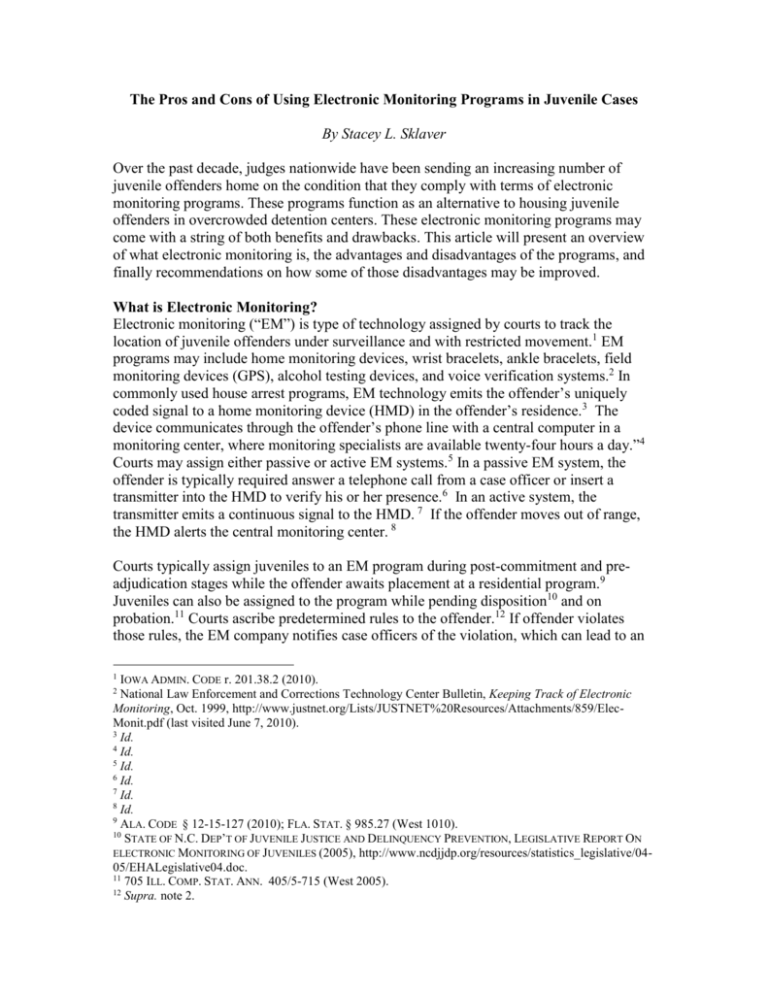The Pros and Cons of Electronic Monitoring
advertisement

The Pros and Cons of Using Electronic Monitoring Programs in Juvenile Cases By Stacey L. Sklaver Over the past decade, judges nationwide have been sending an increasing number of juvenile offenders home on the condition that they comply with terms of electronic monitoring programs. These programs function as an alternative to housing juvenile offenders in overcrowded detention centers. These electronic monitoring programs may come with a string of both benefits and drawbacks. This article will present an overview of what electronic monitoring is, the advantages and disadvantages of the programs, and finally recommendations on how some of those disadvantages may be improved. What is Electronic Monitoring? Electronic monitoring (“EM”) is type of technology assigned by courts to track the location of juvenile offenders under surveillance and with restricted movement.1 EM programs may include home monitoring devices, wrist bracelets, ankle bracelets, field monitoring devices (GPS), alcohol testing devices, and voice verification systems.2 In commonly used house arrest programs, EM technology emits the offender’s uniquely coded signal to a home monitoring device (HMD) in the offender’s residence.3 The device communicates through the offender’s phone line with a central computer in a monitoring center, where monitoring specialists are available twenty-four hours a day.”4 Courts may assign either passive or active EM systems.5 In a passive EM system, the offender is typically required answer a telephone call from a case officer or insert a transmitter into the HMD to verify his or her presence.6 In an active system, the transmitter emits a continuous signal to the HMD. 7 If the offender moves out of range, the HMD alerts the central monitoring center. 8 Courts typically assign juveniles to an EM program during post-commitment and preadjudication stages while the offender awaits placement at a residential program.9 Juveniles can also be assigned to the program while pending disposition10 and on probation.11 Courts ascribe predetermined rules to the offender.12 If offender violates those rules, the EM company notifies case officers of the violation, which can lead to an 1 IOWA ADMIN. CODE r. 201.38.2 (2010). National Law Enforcement and Corrections Technology Center Bulletin, Keeping Track of Electronic Monitoring, Oct. 1999, http://www.justnet.org/Lists/JUSTNET%20Resources/Attachments/859/ElecMonit.pdf (last visited June 7, 2010). 3 Id. 4 Id. 5 Id. 6 Id. 7 Id. 8 Id. 9 ALA. CODE § 12-15-127 (2010); FLA. STAT. § 985.27 (West 1010). 10 STATE OF N.C. DEP’T OF JUVENILE JUSTICE AND DELINQUENCY PREVENTION, LEGISLATIVE REPORT ON ELECTRONIC MONITORING OF JUVENILES (2005), http://www.ncdjjdp.org/resources/statistics_legislative/0405/EHALegislative04.doc. 11 705 ILL. COMP. STAT. ANN. 405/5-715 (West 2005). 12 Supra. note 2. 2 arrest and/or termination from the EM program.13 Violations may include but are not limited to tampering with equipment, deviations from the predetermined schedule, possession or consumption of drugs or alcohol, loss of power to equipment, an excessive busy signal on phone line, tampering with the equipment, and/or loss of phone service.14 Advantages of EM Programs Communities’ Financial Savings Electronic monitoring can save tax-payers, detention facilities, and adjudicated juveniles’ money. For instance, EM programs help reduce the number of juvenile offenders who are placed in residential facilities.15 Financially, this makes a considerable difference as EM programs can range anywhere from $5.50 to $10 per day whereas detention centers can range from $100 to $160 per day.16 After adopting an EM program in one county, the number of juveniles in detention centers decreased from 94 per day in 2003 to 45 per day – a 53% decrease.17 Moreover, the public’s tax burden is reduced as offenders are allowed to work and subsequently pay for the EM costs.18 EM programs can save the juvenile money as well; upon adjudication, a bond may be reduced if the juvenile agrees to submit to electronic monitoring.19 Decreased Recidivism Although research results have been mixed, various reports announce that EM programs improve the chances of a successful rehabilitation for youths by allowing them to remain at home and continue attending school.20 One study yielded a 3% recidivism rate for electronically monitored home detention cases,21 and in Tarrant County, Texas, 242 juveniles utilized the EM program with an 85% success rate in 2002.22 A 2004 report shows that 75% of juveniles who were released from the EM program were considered successful in North Carolina.23 Monitoring and Pinpointing Offenders’ Locations in Real Time EM programs utilizing GPS can pinpoint the offender’s location in real time, which 13 Id. Id. 15 Peter Hall, A New Way to Track Offenders, BUCKS COUNTY COURIER TIMES, Apr. 26, 2010 at 1, available at 2010 WLNR 10087376. 16 Jeff Abell, Juvenile Offenders Housing Costs Spike: Board Explores Pulling Juveniles from Lee County Center, THE HAWK EYE, Mar. 5, 2010 available at 2010 WLNR 4744738; Rex Smith, A Useful, Imperfect Tool Despite the Tragic Shooting of a 5-Year-Old, GPS Monitoring has a Proven Track Record, BALTIMORE SUN, Oct. 23, 2009 at 21A, available at 2009 WLNR 21055672. 17 Juvenile Center Acts to Control Population, COURIER-POST, Sept. 15, 2008, available at 2008 WLNR 26820702. 18 See Supra note 2. 19 Adam Folk, Courts Official Reports Threats Incident Followed Hearing for Teens, AUGUSTA CHRONICLE, May 14, 2010 at B01, available at 2010 WLNR 10982345. 20 Supra note 15. 21 OJJDP Model Programs Guide, Home Confinement/Electronic Monitoring, http://www.dsgonline.com/mpg_non_flash/electronic_monitoring.htm (last visited June 7, 2010). 22 Tarrant County, Immediate Home Detention – Electronic Monitoring, www.tarrantcounty.com/ejuvenile/cwp/view.asp?A=737&Q=427717 (last visited June 7, 2010). 23 See supra note 10. 14 allows law enforcement to ensure juveniles are adhering to the terms and conditions of their release.24 Moreover, pinpointing an offender’s location helps to establish an alibi if the offender is accused of an additional crime or offer evidence if the offender was located at the crime scene.25 It also helps keep track of students who chronically miss school.26 It can provide notification for victims of a sexual offense regarding when the juvenile sex offender is placed on the EM program, the date the EM program was changed with greater or less monitoring capabilities, and the date the offender was removed from the EM program.27 Some systems notify the victim if offender is near the victim’s house or school.28 In addition, the monitoring of the offender allows him or her to receive crisis intervention services around the clock if needed.29 Disadvantages of EM Programs Discrimination against Indigent Families One of the biggest problems with Electronic Monitoring programs is the cost to the juvenile and his or her family. The program can heavily burden indigent parents as many communities still require parents to pay for fees and costs associated with the program.30 Parents are required to set up telephone landlines to activate and maintain EM programs.31 The phone line must be stripped of features such as call waiting, three-way calling, caller ID, or voicemail,32 so some families will have to pay for two landlines if they want those features for personal use. Other costs can include an installation fee, a daily charge for equipment use, random urinalyses, breath analyses, and cost of equipment damaged or not returned.33 If a juvenile and his or her family cannot afford to pay the fees associated with electronic monitoring, the service may be terminated, thus discriminating against indigent families. 24 Rex Smith, A Useful, Imperfect Tool Despite the Tragic Shooting of a 5-Year-Old, GPS Monitoring has a Proven Track Record, BALTIMORE SUN, Oct. 23, 2009 at 21A, available at 2009 WLNR 21055672. 25 Justin Fenton, Lawyers for Teen to Call on GPS Firm Alibi Suggested in Case Where 5-Year-Old was Shot, BALTIMORE SUN, Sept. 4, 2009 at 3A, available at 2009 WLNR 17376903; Michelle Hunter, Four Arrested in Fatal Chase, NEW ORLEANS TIMES PICAYUNE, May 20, 2009 at 1, available at 2009 WLNR 9568985. 26 Laura Maggi, Arrests Show Limits of Ankle Bracelets, NEW ORLEANS TIMES PICAYUNE, Mar. 14, 2009 at 1, available at 2009 WLNR 4861958; Michelle Casady, Staying on top of truancy, THE EAGLE, Jan. 20, 2010, available at 2010 WLNR 1213591. 27 See Supra note 1. 28 See Julie D. Bowden et al., Issues Pertaining to the Juvenile Defendant at Trial, MA-CLE § 11.2.1 (2009). 29 Newport News Department of Juvenile Services, Electronic Monitoring Program, http://www.nngov.com/juvenile-services/resources/electronic-monitoring-program (last visited June 7, 2010). 30 See Supra note 33. 31 Supra note 15. 32 See Supra note 33. 33 City and County of Denver Electronic Monitoring Program, Rules and Participation Agreement – Juvenile Program, http://www.denvergov.org/Portals/676/documents/Juvenile%20Rules.pdf (last visited June 7, 2010); See Supra note 33; Electronic Monitoring, Juvenile Court Services, Spokeane County Washington, http://www.spokeanecoutny.org/juvenilecourt/content.aspx?c=1055 (last visited June 7, 2010). Violations and False Positives Officials cannot track offenders if they leave their designated area although the devices will register the violations.34 In addition, some EM devices that connect a GPS apparatus to a cell phone cannot send out a signal if they are out of cell phone range or have not been charged.35 Other EM devices will send an alert to monitoring personnel, which is identical to alerts generated when offenders leave their designated areas when the cell phone battery is very low or otherwise malfunctions.36 Juveniles may not receive a warning call from their probation officers and may be arrested before they can alert the officers that they have done nothing wrong.37 Flight Risks and Emotional Effects Many researchers worry about the social and psychological impact of the stigma of wearing a visible electronic monitoring device on the juvenile offender38 and whether that will influence their compliance with the EM program. According to a study conducted in Monroe, Niagara, and Onondaga counties in New York, of 115 juveniles involved with the EM program, 64% of juveniles who failed to complete their term of EM cut off their ankle bracelets, generally thought to be the result of coping difficulties.39 When the juvenile wears an EM device, he or she feels like a criminal, and may start behaving as such.40 In addition, juveniles with a history of running away and those with a prior Person In Need of Supervision (“PINS”) referral were disproportionately more likely to cut their bracelets.41 Recommendations While EM programs have various drawbacks, steps can be taken to lessen these disadvantages. Further research should be conducted to determine the lasting emotional and psychological effects of electronic monitoring in comparison to its alternatives. While some counties openly admit that they do not have enough research to make a conclusion one way or the other,42 others have reported that EM programs have positive psychological effects in general.43 One study noted that the offenders were not treated differently by peers and supervisors and that the EM devices served as a constant reminder of consequences therefore serving as a psychological deterrent 34 See Supra note 33; Tricia Bishop, Teen Faces Charges After Slipping GPS, BALTIMORE SUN, MAY 18, 2010 at 1A, available at 2010 WLNR 10270751. 35 See Supra note 33. 36 Id. 37 Id. 38 Michael T. Charles, Research Notes: Juveniles on Electronic Monitoring¸ 5 JOURNAL OF CONTEMPORARY CRIMINAL JUSTICE ONLINE 165, 167 (1989). 39 Id. 40 Michelle Casady, Staying on top of truancy, THE EAGLE, Jan. 20, 2010, available at 2010 WLNR 1213591. 41 Id. 42 John F. Tewey, Maryland Task Force to Study Criminal Offender Monitoring by Global Positioning Systems, Final Report to the Governor and General Assembly (Dec. 31, 2005), available at http://www.dpscs.state.md.us/publicinfo/publications/pdfs/GPS_Task_Force_Final_Report.pdf/. 43 See supra note 38. from entering into further bad behavior.44 In terms of short-battery life in connection with GPS monitoring, the juvenile offender’s attorney should strenuously remind the offender that if the battery drains quickly on the cell phone, he or she should notify the probation officer immediately, and request either a new battery of a new GPS cell phone.45 Regarding indigent families that cannot afford electronic monitoring, the United States and state, local and territorial governments should fund the program by covering all associated costs. If tax dollars are unavailable to cover the EM program in its entirety, the United States and state, local and territorial governments should offer low-income families a subsidized plan and indigent juveniles the option to perform community service in lieu of payment. For instance, Sussex County, New Jersey offers a sliding-scale payment or community service plan option: parents or guardians earning less than $50,000 annually combined or unemployed and/or receiving public assistance can pay $5 per day or require the offender to provide five hours of community service per day.46 Parents or guardians earning between $50,000 and $75,000 can pay $10 per day or require the offender to provide ten hours of community service, and parents or guardians earning more than $100,000 can pay $20 per day or twenty hours worth of community service.47 No child who qualifies for the EM program should be denied this option solely due to his or her families’ economic status. The Section will bring a resolution to the ABA House of Delegates to address costs of juvenile electronic monitoring in the upcoming months. For more information, visit www.abanet.org/crimjust. 44 Id. Julie D. Bowden et al., Issues Pertaining to the Juvenile Defendant at Trial, MA-CLE § 11.2.1 (2009) 46 Joe Moszczynski, Sussex will Charge Parents a Fee for Youths’ Home Confinement, THE STAR-LEDGER, Apr. 18, 2010 at 29, available at 2010 WLNR 8034412. 47 Id. 45







